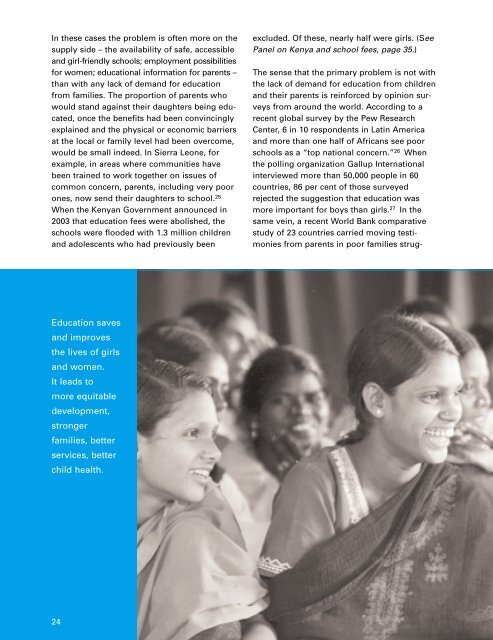THE STATE OF THE WORLD'S CHILDREN 2004 - Unicef
THE STATE OF THE WORLD'S CHILDREN 2004 - Unicef
THE STATE OF THE WORLD'S CHILDREN 2004 - Unicef
You also want an ePaper? Increase the reach of your titles
YUMPU automatically turns print PDFs into web optimized ePapers that Google loves.
In these cases the problem is often more on the<br />
supply side – the availability of safe, accessible<br />
and girl-friendly schools; employment possibilities<br />
for women; educational information for parents –<br />
than with any lack of demand for education<br />
from families. The proportion of parents who<br />
would stand against their daughters being educated,<br />
once the benefits had been convincingly<br />
explained and the physical or economic barriers<br />
at the local or family level had been overcome,<br />
would be small indeed. In Sierra Leone, for<br />
example, in areas where communities have<br />
been trained to work together on issues of<br />
common concern, parents, including very poor<br />
ones, now send their daughters to school. 25<br />
When the Kenyan Government announced in<br />
2003 that education fees were abolished, the<br />
schools were flooded with 1.3 million children<br />
and adolescents who had previously been<br />
excluded. Of these, nearly half were girls. (See<br />
Panel on Kenya and school fees, page 35.)<br />
The sense that the primary problem is not with<br />
the lack of demand for education from children<br />
and their parents is reinforced by opinion surveys<br />
from around the world. According to a<br />
recent global survey by the Pew Research<br />
Center, 6 in 10 respondents in Latin America<br />
and more than one half of Africans see poor<br />
schools as a “top national concern.” 26 When<br />
the polling organization Gallup International<br />
interviewed more than 50,000 people in 60<br />
countries, 86 per cent of those surveyed<br />
rejected the suggestion that education was<br />
more important for boys than girls. 27 In the<br />
same vein, a recent World Bank comparative<br />
study of 23 countries carried moving testimonies<br />
from parents in poor families strug-<br />
Education saves<br />
and improves<br />
the lives of girls<br />
and women.<br />
It leads to<br />
more equitable<br />
development,<br />
stronger<br />
families, better<br />
services, better<br />
child health.<br />
24
















